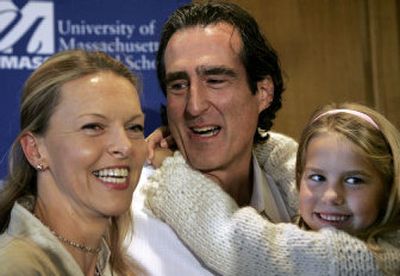UMass, Stanford scientists share Nobel

Two American scientists awakened early Monday to learn they will share a Nobel Prize for their discovery of a gene-regulating mechanism inside cells, an advance that has revolutionized genetics in just eight short years and has led to several experimental treatments of diseases.
Craig Mello of the University of Massachusetts Medical School in Worcester – whose father, a paleontologist, served for years as an associate director of the National Museum of Natural History – and Andrew Fire of Stanford University’s School of Medicine will share the $1.36 million Nobel Prize in physiology or medicine for their serendipitous discovery of RNA interference, or “RNAi.”
In a series of experiments on nearly microscopic soil-dwelling worms conducted at the Carnegie Institution of Washington in Baltimore, the team stumbled upon a naturally occurring mechanism that allows cells to shut down individual genes.
That mechanism, RNAi, appears to have evolved more than a billion years ago, helping plants and fungi defend themselves against invading viruses.
But in more complex organisms, including humans, that molecular machinery has taken on more complicated functions. Chief among them is the delicate job of shutting down a cell’s own genes once those genes have completed a task.
After discovering the mechanism, Fire, Mello and others quickly figured out how to harness it. Today, RNAi is an essential tool for scientists trying to understand the functions of various genes – just turn one off and see what happens. And RNAi is at the core of several young biotechnology companies developing therapies that work by turning off troublesome genes.
“One of the exciting things about this work is that even though it’s been only eight years since their paper was published, it already has obvious therapeutic potential,” said Jeremy Berg, director of the National Institute for General Medical Sciences, the branch of the National Institutes of Health that funded much of the work.
Mello said he missed the 4:30 a.m. call from Sweden because his wife picked up the phone and quickly hung up, believing it was a prank. When it rang a second time a few minutes later, she called out, “Don’t answer it. It’s a crank call!” Mello said in an interview.
Cautiously optimistic but fearing it was a friend with a bad sense of humor, he picked up the phone. Before long, he was putting in a wake-up call to his parents, who now run an organic farm at Rixeyville, Va.
It was Mello’s excellent high school biology teacher, since retired, who set him on his path as a scientist, his mother, Sally, said later in an interview.
The work that won Mello, 45, and Fire, 47, the coveted prize began in the mid-1990s when they and others were experimenting with “antisense RNA,” a then-promising method for modulating the activity of genes inside cells.
Genes are stretches of DNA, each one bearing a molecular code that directs the production of a particular protein such as a hormone or enzyme. But for a gene – which is made of DNA – to make a protein, it must work through an intermediary molecule called messenger RNA.
Antisense RNA technology used synthetic strands of RNA to deactivate messenger RNA, effectively blocking a gene’s activity and preventing production of a particular protein. But that process never worked as well as scientists had predicted.
In experiments on millimeter-long worms, Mello and Fire found that injections of paired strands of RNA – which they included as “controls” because pairs would be expected to cancel each other out and have no effect – inhibited genes far more efficiently than single strands of antisense RNA.
That made no sense, said Thomas Cech, who won a Nobel Prize in 1989 for his work on RNA and now is president of the Howard Hughes Medical Institute, which funds Mello’s work.
” ‘Who mixed up these tubes anyway?’ That must have been what they were saying,” Cech said. “The whole thing was so damned surprising.”
Further experiments revealed that cells of virtually all organisms are endowed with a mechanism that detects double-stranded RNA and breaks it into little pieces. At first, it probably was a way of defending against viruses, most of which use RNA rather than DNA as their genetic material.
Later, it appears, evolution helped organisms use elements of that system to turn off their own genes. The system involves the production of “short interfering RNAs” and “microRNAs,” short pieces of RNA that can attach to messenger RNA, thus making double-stranded RNA.
Some of the RNA interacts with one or both of a pair of proteins – dubbed “dicer” and “slicer” by scientists who apparently spent too much time watching late-night advertisements for food processors. From there, a chain reaction of events ends up destroying the targeted messenger RNA and snuffing that gene’s impact on the body.
Several companies have begun to design therapies that take advantage of RNAi.
Acuity Pharmaceuticals of Philadelphia has completed phase two efficacy studies of an RNAi that shuts down a gene responsible for new blood vessel growth. Injected into the eyes of patients with age-related macular degeneration (AMD), a common cause of blindness in older adults, it blocked the overgrowth of blood vessels that is the cause of that disease.
The approach is not without challenges, though. Interfering RNA molecules are about 50 times larger than conventional drug molecules, posing difficulties getting them to where they are needed in the body. Some have also proven toxic in animal tests.